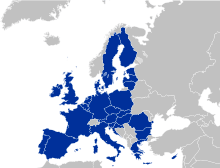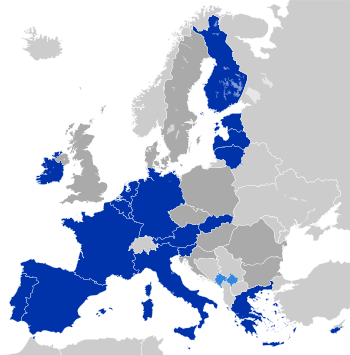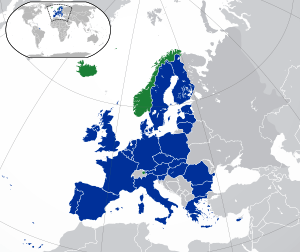Eurostat

Eurostat (European Statistical Office) is a Directorate-General of the European Commission located in Luxembourg. Its main responsibilities are to provide statistical information to the institutions of the European Union (EU) and to promote the harmonisation of statistical methods across its member states and candidates for accession as well as EFTA countries. The organisations in the different countries that cooperate with Eurostat are summarised under the concept of the European Statistical System.
Organisation
Eurostat operates pursuant to Regulation (EC) No 223/2009. As a Directorate-General of the Commission, Eurostat is allocated to the portfolio of the European Commissioner for Employment, Social Affairs, Skills and Labour Mobility, a position occupied as of April 2015 by Marianne Thyssen.[1]
The Director-General of Eurostat is Mariana Kotzeva, former Deputy Director-General of Eurostat and President of the National Statistical Institute of Bulgaria.[2][3]
History
- 1953 The Statistics Division for the European Coal and Steel Community established.
- 1958 The European Community founded and the forerunner of Eurostat established.
- 1959 The present name of Eurostat as the Statistical Office of the European Communities adopted. First publication issued - on agricultural statistics.
- 1960 First Community Labour Force Survey.
- 1970 The European System of Integrated Economic Accounts (European System of Accounts, ESA) published and the general Statistical Classification of Economic Activities in the European Community (NACE) established.
- 1974 First domain in the statistical database Cronos databank installed.
- 1988 European Commission adopts a document defining the first policy for statistical information.
- 1989 The Statistical Programme Committee established and the first programme (1989–1992) adopted by the Council as an instrument for implementing statistical information policy.
- 1990 The Council adopts a directive on transmission of confidential data to Eurostat, previously an obstacle to Community statistical work.
- 1991 Eurostat’s role extended as a result of the agreement on establishment of the European Economic Area and adoption of the Maastricht Treaty.
- 1993 The single market extends Eurostat’s activities e.g. Intrastat established for statistics on intra-EU trade. Eurostat starts issuing regular news releases.
- 1994 First European household panel held, analysing income, employment, poverty, social exclusion, households, health, etc.
- 1997 Statistics added for the first time to the Treaty of Amsterdam and the Statistical Law approved by the Council. Harmonised Indices of Consumer Prices HICP published for the first time - designed for Economic and Monetary Union of the European Union (EMU) convergence criteria.
- 1998 The eleven countries in at the start of EMU (EUR-11) announced, and Eurostat issues the first indicators specific to the EMU area.
- 1999 Start of EMU, 1 January 2001.
- 2001 In April, Eurostat, in collaboration with five other international organisations (APEC, IAE, OLADE, OPEC, UNSD) launched the Joint Oil Data Exercise, which in 2005 became the Joint Organisations Data Initiative (JODI).
- 2002 Start of the Euro on 1 January, Eurostat supplies key statistics for monetary policy.
- 2003 Irregularities were suspected in Eurostat, see Eurostat scandal.
- 2004 Start of free-of-charge dissemination of all statistical data except microdata for research purposes.
- 2005 Commission Recommendation on the independence, integrity and Accountability of the National and Community Statistical Authorities (European Statistics Code of Practice)
- 2005 Start of a three-year peer review exercise across the European Statistical System to monitor compliance with the Code of Practice.
- 2007 The currently valid five-year Statistical Programme 2008-2012 was adopted.
- 2009 New European Regulation governing statistical cooperation in the European Union was adopted.
- 2010 Following strong criticism, from within the EU and otherwise, of how it had handled inaccurate data regarding Greece, Eurostat published a report[4] to try to rectify its procedures. The European Commission proposes powers for Eurostat to audit the books of national governments in response to the Greek government-debt crisis.[5]
- 2011 Revision of European Statistics Code of Practice by the European Statistical System Committee.[6]
Directors General
| Name | Nationality | Term |
|---|---|---|
| Rolf Wagenführ | 1952–1966 | |
| Raymond Dumas | 1966–1973 | |
| Jacques Mayer | 1973–1977 | |
| Aage Dornonville de la Cour | 1977–1982 | |
| Pieter de Geus | 1982–1984 | |
| Silvio Ronchetti | 1984–1987 | |
| Yves Franchet | 1987–2003 | |
| Michel Vanden Abeele | 2003–2004 | |
| Günther Hanreich | 2004–2006 | |
| Hervé Carré | 2006–2008 | |
| Walter Radermacher | 2008–2016 | |
| Mariana Kotzeva (acting) | 2017–present |
Regulations
The Regulation (EC) No 223/2009 of the European Parliament and of the Council of 11 March 2009 on European statistics establishes the legal framework for the European statistics[7].
Amending Regulation (EU) 759/2015 clarifies that heads of NSIs coordinate national level activities for European statistics and decide on processes, methods, standards and procedures of their respective statistics.[8].
Previous Eurostat regulations were a Decision on Eurostat (2012/504/EU), and the earlier Decision on Eurostat (97/281/EC).
Main areas of statistical activities
The Eurostat statistical work is structured into Themes and Sub-themes.
EU Policy Indicators
|
General and regional statistics
|
Economy and finance
|
Population and social conditions
|
Industry, trade and services
|
Agriculture and fisheries
|
| External trade | Transport |
Environment and energy
|
Science and technology |
General statistical activities related to the European Statistical system are:
- Coordination and governance of the European Statistical System
- Statistical methodological coordination and research
- Statistical quality and reporting
Geographical scope
Currently Eurostat data are aggregated at EU-28 level, known as EU-28. While Brexit is planned for 29 March 2019, it is expected that after the Brexit date they will be computed for the EU-27 only as the Brexit will make the UK to be a third country. Nonetheless, to avoid confusion with the previous EU-27 group of 27 member state — which was used in series of statistical data before the accession on the member state number 28 — another name for the future EU 27 — without UK — might be defined after, according to Eurostat[9]. The concept of EU 28 is used from 1st January 2014, also according to Eurostat Methodological manual on city statistics 2017 edition.
Eurostat is also engaged in cooperation with third countries, such as: European Statistical System, EU Enlargement Policy, European Neighbourhood Policy.[10]. Statistical cooperation in and around Europe
Local data are also computed at NUTS level.
Access to Eurostat statistics
The most important statistics are made available via press releases. They are placed on the Eurostat website at 11:00 in the morning. This is also the time that the press release content may be distributed to the public by press agencies.
Eurostat disseminates its statistics free of charge via its Internet and its statistical databases that are accessible via the Internet. The statistics are hierarchically ordered in a navigation tree. Tables are distinguished from multi-dimensional datasets from which the statistics are extracted via an interactive tool.
In addition various printed publications are available either in electronic form free on the internet or in printed form via the EU Bookshop. Only larger publications are charged for as printed copies.
Since September 2009 Eurostat has pioneered a fully electronical way of publishing, Statistics Explained,[11] like Wikipedia based on Mediawiki open source software and with a largely similar structure and navigation. Statistics Explained is not only a dissemination format, however, but also a wiki working platform for producing flagship publications like the Eurostat Yearbook.[12]
Ireland now has the lowest tax-to-GDP measure across 30 European countries, new figures from Eurostat have shown. The metric is calculated by dividing the tax revenue collected by the Government from the gross domestic product (GDP).
Statistical data for research purposes
Microdata, which in principle allows the identification of the statistical unit (e.g. a person in the labour force survey or a company for innovation statistics), is treated as strictly confidential. Under tight security procedures various anonymised datasets are provided to research institutions for validated research projects.
See also
References
- ↑ "Commissioner Marianne Thyssen". Ec.europa.eu. 2014-11-01. Retrieved 2015-04-09.
- ↑ "Eurostat>MEET OUR ACTING DIRECTOR-GENERAL". Archived from the original on 2017-10-18. Retrieved 2017-02-04.
- ↑ "Meet our Director-General - Eurostat". ec.europa.eu. Retrieved 2018-06-19.
- ↑ Archived October 8, 2013, at the Wayback Machine.
- ↑ Castle, Stephen; Saltmarsh, Matthew (15 February 2010). "Greece Pressed to Take Action on Economic Woes". The New York Times.
… the European Commission proposed powers for Eurostat to audit the books of national governments
- ↑ "European Statistics Code of Practice". eurostat. Archived from the original on 2011-05-20.
- ↑ http://ec.europa.eu/eurostat/statistics-explained/index.php/Eurostat_and_the_European_Statistical_System
- ↑ http://ec.europa.eu/eurostat/statistics-explained/index.php/Eurostat_and_the_European_Statistical_System
- ↑ http://ec.europa.eu/eurostat/documents/3859598/8012444/KS-GQ-17-006-EN-N.pdf/a3f1004f-cfae-4cc4-87da-81d588d67ae2
- ↑ http://ec.europa.eu/eurostat/web/products-eurostat-news/-/WDN-20180924-1
- ↑ "Statistics Explained". Epp.eurostat.ec.europa.eu. Retrieved 2012-10-18.
- ↑ Archived August 12, 2011, at the Wayback Machine.
External links
- Official website
- - wiki-based encyclopaedia / glossary / portal for EU statistics
- EU Open Data Portal
- Health-EU Portal the official public health portal of the European Union
- Eurostat->Matlab Automated data importing tool from Eurostat to Matlab
| Wikimedia Commons has media related to Eurostat. |



